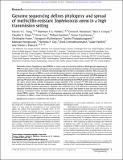Genome sequencing defines phylogeny and spread of methicillin-resistant Staphylococcus aureus in a high transmission setting
Abstract
Methicillin-resistant Staphylococcus aureus (MRSA) is a major cause of nosocomial infection. Whole-genome sequencing of MRSA has been used to define phylogeny and transmission in well-resourced healthcare settings, yet the greatest burden of nosocomial infection occurs in resource-restricted settings where barriers to transmission are lower. Here, we study the flux and genetic diversity of MRSA on ward and individual patient levels in a hospital where transmission was common. We repeatedly screened all patients on two intensive care units for MRSA carriage over a 3-mo period. All MRSA belonged to multilocus sequence type 239 (ST 239). We defined the population structure and charted the spread of MRSA by sequencing 79 isolates from 46 patients and five members of staff, including the first MRSA-positive screen isolates and up to two repeat isolates where available. Phylogenetic analysis identified a flux of distinct ST 239 clades over time in each intensive care unit. In total, five main clades were identified, which varied in the carriage of plasmids encoding antiseptic and antimicrobial resistance determinants. Sequence data confirmed intra- and interwards transmission events and identified individual patients who were colonized by more than one clade. One patient on each unit was the source of numerous transmission events, and deep sampling of one of these cases demonstrated colonization with a "cloud" of related MRSA variants. The application of whole-genome sequencing and analysis provides novel insights into the transmission of MRSA in under-resourced healthcare settings and has relevance to wider global health.
Citation
Tong , S Y C , Holden , M T G , Nickerson , E K , Cooper , B S , Köser , C U , Cori , A , Jombart , T , Cauchemez , S , Fraser , C , Wuthiekanun , V , Thaipadungpanit , J , Hongsuwan , M , Day , N P , Limmathurotsakul , D , Parkhill , J & Peacock , S J 2014 , ' Genome sequencing defines phylogeny and spread of methicillin-resistant Staphylococcus aureus in a high transmission setting ' , Genome Research , vol. 25 , no. 2 , pp. 111-118 . https://doi.org/10.1101/gr.174730.114
Publication
Genome Research
Status
Peer reviewed
ISSN
1088-9051Type
Journal article
Description
The authors acknowledge financial support from the UKCRC Translational Infection Research (TIR) Initiative and the Medical Research Council (Grant number G1000803), with contributions to the grant from the Biotechnology and Biological Sciences Research Council, the National Institute for Health Research on behalf of the Department of Health, and the Chief Scientist Office of the Scottish Government Health Directorate (to Professor Peacock); from Wellcome Trust grant number 098051 awarded to the Wellcome Trust Sanger Institute; and the NIHR Cambridge Biomedical Research Centre (to Professor Peacock). S.Y.C.T. is an Australian National Health and Medical Research Council Career Development Fellow (1065736).Collections
Items in the St Andrews Research Repository are protected by copyright, with all rights reserved, unless otherwise indicated.

